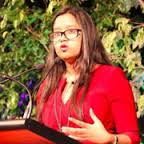A full assessment of the SDGs, let alone of their implementation, will not be possible for some time. What is clear enough is that they differ from the MDGs and from most development efforts of the last decades in two important aspects: 1) They approach development as a global activity, involving all countries, as opposed to an area defined by deficiencies in low-income countries in the Global South; 2)They address numerous aspects where developmental improvements have been promised before but whose ongoing trends are uncertain or downright negative, such as climate change, global arms expenditures, deforestation, desertification, waste production or road traffic deaths

by Iris Borowy
professor of History at Shanghai University, College of Liberal Arts
Development and Health: Some Thoughts on the Sustainable Development Goals
The beginning of 2016 has marked the official launch of the Sustainable Development Goals (SDGs), a list of seventeen goals, specified by a total of 169 targets, to be reached by 2030. They replace the Millennium Development Goals (MDGs), which were established between 2000 and 2005 and lasted until 2015. Admittedly, the SDGs are symbolic rather than legally binding and they cannot commit any government or any institution to do anything. But, symbols can have powerful effects, and following the precedent of the Millennium Development Goals, the SDGs come as part of a reasonably established system of international cooperation based on a set of recognized goals. The list covers a broad range of aspects:
- End poverty in all its forms everywhere
- End hunger, achieve food security and improved nutrition, and promote sustainable agriculture
- Ensure healthy lives and promote wellbeing for all at all ages
- Ensure inclusive and equitable quality education and promote lifelong learning opportunities for all
- Achieve gender equality and empower all women and girls
- Ensure availability and sustainable management of water and sanitation for all
- Ensure access to affordable, reliable, sustainable and modern energy for all
- Promote sustained, inclusive and sustainable economic growth, full and productive employment, and decent work for all
- Build resilient infrastructure, promote inclusive and sustainable industrialisation, and foster innovation
- Reduce inequality within and among countries
- Make cities and human settlements inclusive, safe, resilient and sustainable
- Ensure sustainable consumption and production patterns
- Take urgent action to combat climate change and its impacts
- Conserve and sustainably use the oceans, seas and marine resources for sustainable development
- Protect, restore and promote sustainable use of terrestrial ecosystems, sustainably manage forests, combat desertification and halt and reverse land degradation, and halt biodiversity loss
- Promote peaceful and inclusive societies for sustainable development, provide access to justice for all and build effective, accountable and inclusive institutions at all levels
- Strengthen the means of implementation and revitalise the global partnership for sustainable development
At first sight, this seem rather a disappointing loss of attention to health issues as compared to the MDGs, where four out of eight goals directly addressed health. This time, merely goals 2 (an end to hunger and malnutrition) and 3 (to ensure healthy lives), directly address health, and goals 6 (water and sanitation) and 5 (gender equality and empowerment women) only a little less directly, since the connection both between sanitation and the position of women and (especially infant and maternal) health is well established. Thus, by comparison, one might conclude that health had been downgraded to give way to other developmental priorities.
This paper argues that nothing could be further from the truth. Without doubt, the MDGs presented an agenda strong on health, and in 2010 WHO prided itself about contributing to them in twenty ways. But, tellingly, all were policies that were directly tied to medical or health management procedures. What the step from MDGs to SDGs brought was not so much a weakening of a commitment to health as a shift in perspective on health from a primarily local and direct to a primarily global and indirect approach. This change is hardly out of line with earlier policies of international health. WHO, other institutions and scholars have insisted for a long time that health care provides only part of what is required to maintain good health. It is the social determinants which play an important, and arguably a much larger role.
In this sense, most or, indeed, all of the SDGs can be read as being related to health. Reducing poverty, improving education, providing sufficient energy which causes neither pollution nor nuclear contamination nor climate change, improving living standards, providing lucrative and healthful employment, reducing inter- and intrastate inequality, providing safe and healthy urban living environments, promoting sustainable economies and lifestyles, mitigating climate change, conserving ocean resources, preventing desertification and biodiversity loss, preventing warfare and promoting global partnership all interact in one way or the other with people’s health around the world. Thus, the SDGs can be seen as a strongly social approach to health within the vacillations between bio-medical and social approaches which have characterized the approaches to international health policies throughout the twentieth century and beyond. Besides, it is difficult to conceive of developmental processes not having an impact on and being influenced by a country’s development. So, simply by being the paramount recent initiative in global development, the SDGs are of relevance to considerations of global health.
Development: the record
The SDGs use the expression of “development” as though its meaning was clear and universally accepted. However, the concept is not easy to define and has become a vehemently contested field. Left-wing activists or scholars frequently reject the concept as a thinly veiled euphemism for a process of rigging global structures and perceptions of reality to benefit the global rich at the expense of the global poor, a view taken by writers such as Arturo Escobar and Gilbert Rist since the early 1990s. Public debate between experts has centered on whether financial transfers from the North to the South through development aid is necessary to improve living conditions in the South (argued e.g. by Jeffrey Sachs) or whether such assistance is counterproductive and should be discontinued (e.g. argued by his former student Dambisa Moyo). Still others, especially on the political right, have simply tired of seemingly endless and fruitless efforts to turn Africa and the world in general into a place without poverty and misery.
Given this record of pessimism and rejection, the SDGs are remarkably untouched by doubt and modesty. On the contrary, some of these goals seem ambitious to the point of utter neglect of realism. Already the first goal is downright provocative. Will it really be possible to end poverty in all its forms everywhere in a mere fifteen years? In fairness, UN officials are not the only ones who think so. Hans Rosling does, too. The Swedish professor with a mission to acquaint people with statistics argues passionately, that eradicating poverty is possible and perfectly in line with enormous reductions of world poverty since 1970s. And poverty as simple lack of income is not the only field that is improving more rapidly than is generally realized. As the ignorance project of the gapminder foundation shows, many people dramatically underestimate the impressive ways in which recent development has been successful. (Those who would like to test their own ignorance, can read the nine questions and compare their answers to those of Swedes, Norwegians, Americans, Germans or South Africans.) Key criteria of wellbeing, notably health data such as life expectancy, infant mortality and hunger, have improved substantially during the last 200 years, along with literacy and income (See the interactive graphs supplied by gapminder.) As a long-term trend, improvements in income and life expectancy are also borne out by the data by late economic historian Angus Maddison and, for the twentieth century, by the UN Development Programme. In its 2015 Human Development Report, it shows that the UN development index, an index consisting of per capita gross national income, education and health, shows improvements in all regions of the world.
These reports are in stark contrast to a persistent narrative regarding the uselessness of development. When Rist cites increasing global income inequality during the last forty years as proof of “undeniable failures in improving the condition of millions of the poor” he overlooks the very real improvements of health of millions of poor people, notably with regard to sanitation, nutrition or life expectancy. Clearly, recent global development has neither been limited to helping the rich, nor has it been fruitless, and whoever argues that falling infant mortality rates do not represent improvement lacks the experience or the empathy to imagine the pain of parents who lose a child. However, Rist is also right in pointing out that improvements have been very uneven and that they have been accompanied by marked deteriorations in other fields.
Part of the challenge is inequality within societies, which has clearly increased in many countries during the last decades. In part, this development is related to the systemically differing growth rates of capital and of the economies at large, as recently described by Thomas Piketty. But in a short-term perspective, this effect is amplified by political influence through legal donation and bribery, legal and illegal tax avoidance, and through an inflated financial sector which now accounts for one in five billionaires and which allows huge gains for some while reducing the bargaining position of labour. This goes hand in hand with a larger potentially destabilizing effect of a financial sector which is increasingly disconnected from the real economy. The danger showed during the recent financial crisis, which turned into debt crisis and then into an austerity crisis. Despite initial measures to reform the banking system, many of these are quietly being weakened or removed again. Besides, key structural risk factors such as multifunction banks, the separation of high-risk investment from accountability and generally a culture of too-big-to-fail remain in place. At the same time, economic inequality itself bears the risk of destabilizing financial systems, since the very poor are tempted to borrow money to achieve a living standard they cannot afford and the very rich have a lot of money which they wish to profit from by lending it out. Besides, inequality within wealthy nations is measurably and positively correlated to health impairment such as shortened life expectancy, higher rates of infant mortality, drug abuse, teenage pregnancies, obesity, homicides and mental illness.
Inequality between countries is more complicated. The issue came, once again, to the forefront of public attention when a recent Oxfam report declared that in 2015, a mere 62 individuals owned the same amount of wealth as the bottom half of the global population, 3.6 billion people. This forms a dramatic concentration of wealth even since 2010 when 388 of the richest people were needed to match the wealth of the bottom half. During those five years, the richest 62 people saw their wealth increase by 44 per cent, matched by a drop of wealth among the poorest half of the global population by 41 per cent.
However, this focus on the richest of the rich obscures the larger picture of the overall distribution of global wealth. True, the Gini coefficient (a measure of inequality with 0 expressing perfect equality and 1 perfect inequality or 1 person owning everything) of the world at large remains scandalously high, higher than any individual country. But according to calculations by Christoph Lakner and Branko Milanovic, the impressive economic developments in India and, particularly, in China have moved several millions of people from utter poverty to levels of modest comfort and thereby closer to a living standard enjoyed in high-income countries. As a result, global inequality has been falling since the late 1980s in the sense that wealth differences between a majority of global population are diminishing. However, not everyone participates equally in this move: large parts of people in Africa and the lower income sectors of traditionally high-income countries in Europe and North America have seen only modest increases, at best. As a result, most people in Africa tend to be even more on the losing end of development, relative to the rest of the world, while (lower) middle class people in North America and Europe barely hang on to their absolute wealth status which is still above that enjoyed by the average Indian or Chinese, but they are losing ground, relatively, both to these Indians and Chinese and to those with high incomes in their own countries. In crude terms, the growing number of refugees of recent times tend to be those whom global development has failed, and when coming to the traditionally rich countries in Europe and North America, they are meeting a growing percentage of people, whom global development seems to failing today. Clearly, it is an explosive – and clearly unhealthy – combination.
The picture becomes even bleaker when considering the reasons for the perceived positive development in Southern and Southeastern Asia, defined mainly as rapidly growing income. China provides a particularly revealing example. Approximately 600 million people have been raised from poverty, an immense achievement, whose beneficial effects for people’s health and overall wellbeing should not be minimized. But the Chinese people have been paying a heavy price in terms of environmental destruction, pollution, increasing domestic inequality, growing risks to food security due to farmland degradation and widespread corruption. The development has privileged the urban over the rural population, involving some extreme concentration of wealth with five percent of the population owing an estimated 95 percent of the country’s wealth. The environmental burden has been similarly dramatic. Accounts different as to whether seven or only two of the ten most polluted cities of the world are in China, but there is general agreement that the pollution level in Chinese cities is high. The massive demand of resources had increased the risk of widespread resources depletion. China has had to import dramatically increasing amounts of coal to sustain its economic growth, and 60 percent of Chinese cities with a population of over 100,000 people are experiencing water shortages. In the interest of rapid industrialization and GDP growth, huge amounts of concentrated organic waste water and hazardous wastes have been released into the environment. Two thirds of Chinese rivers are seriously polluted and over 80 percent of urban rivers are seriously degraded. People living in the vicinity of clusters of polluting enterprises are especially at risk, both from industrial accidents, releasing large amounts of toxic substances, and from ongoing high levels of emissions. A growing number of villages (“death villages”) show significantly elevated numbers in cancer and overall mortality. Unlike in the European countries or in the US, it is not ethnic minorities or the poor who bear the highest environmental burdens but, on the contrary, it seems to be that those who have profited most from economic development also suffer most from its environmental repercussions.
Otherwise, China merely appears to show a concentrated form of the global development. Less polluted living conditions in wealthier countries notwithstanding, the world at large has gained economic wealth at the expense of future life support systems. Humanity probably began living beyond its ecological means in the early 1970s. Today, the world is using the resources and waste absorption capacities of approximately 1.5 planets per time unit. 15 out of 24 crucial ecosystem services, evaluated by the Millennium Ecosystem Assessment in 2005, were degraded or being used unsustainably, including fresh water, air and water purification, climate regulation and pest control. And the world may be heading towards a four degree temperature rise promising inundated coastal cities, increased food insecurity, frequent high-intensity tropical storms and further irreversible loss of biodiversity by the end of this century. Adding environmental to social challenges, the damages of climate change will be unevenly distributed, affecting primarily those already poor and vulnerable. If wellbeing has been improving worldwide during the last decades, there is reason to be skeptical about whether it will continue to do so in the future.
These developmental challenges have everything to do with other acute political problems we are facing today. Unequal development and economic instability provide conditions in which some will not find jobs and recognition and will be tempted to look for social respect in extremist ideologies. Unequal development produces the refugees who are fleeing from environmental degradation and poverty or from living conditions which, though not absolute poverty, they know to be immeasurably worse than those considered normal in high-income countries. Even those situations of repression and warfare, like in Syria, which are seemingly unrelated to development in a narrow sense often turn out to have been influenced by developmental factors. Thus, there is good evidence that unusual droughts in Syria between 2006 and 2009 reflected climate change and contributed to the social stress which led to the uprising against the government of Bashar al-Assad. It does not require a lot of imagination to realize that further environmental degradation, caused by climate change or otherwise, will further increase the numbers of disillusioned people, who will seek redress for their disadvantages – perceived or real enough – by seeking to move to other countries as refugees or terrorists.
Development: conclusions from the record
Clearly, global development is both going well and going terribly wrong, and the big – and urgent – challenge is to find a mode of development that safeguards much of what is going well (the increasing income, increasing life expectancy, decreasing infant mortality…) while avoiding what is going wrong (climate change, environmental degradation, social fragmentation). The SDGs are the most serious and comprehensive international attempt, as yet, to galvanize a critical mass of organizations and institutions into taking serious steps towards such a form of development. While “sustainable development” has been derided by many, by those who see it as a front for business as usual as well as by those who believe in the long-term benefits of business as usual and see little need to change it. Indeed, the SDGs also entail inherent contradictions, particularly with regard to health, as, indeed, I have argued elsewhere. Thus, it is at present difficult to see how the calls for “per capita economic growth in accordance with national circumstances, and in particular at least 7% per annum GDP growth in the least-developed countries” (goal 8) and plans to “promote inclusive and sustainable industrialization, and by 2030 raise significantly industry’s share of employment and GDP … and double its share in LDCs” (goal 9) can in practice be reconciled with the tasks to “integrate climate change measures into national policies, strategies and planning” (goal 13) and to “substantially reduce waste generation through prevention, reduction, recycling and reuse” (goal 12). Thomas Pogge and Mitus Sengupta have criticized the SDGs for perceived crucial weaknesses: no clear responsibility and accountability for implementation, insufficient demand of structural reforms of the global institutional order, insufficient attention to human rights, an absence of suitable measurements of progress, insufficient clarity on necessary measures to combat climate change and a misguided focus on only the illegal portion of frequently destructive practices like arms trade and high-risk financial investments.
All this may be true. But the perfect is enemy of the good. And, compared to earlier plans, notably the MDGs, progress seems substantial. The MDGs, for all their – welcome – focus on health, took a largely end-of-pipe approach to development and health, assuming that (health) problems in parts of the world should be addressed by specific health policies directed at that part of the world. In other words, if children were dying in low-income countries, the remedy had to be found in health interventions directed at children in low-income countries, such as vaccinations. Vaccinations are important, and giving all children worldwide access to them is also an important goal. But children’s health is affected by a lot of other factors as well, only some of which lie in their immediate surroundings.
But the MDGs set an important precedent by turning development into a global action, in which an unprecedented number of organizations cooperated on what was endorsed as a common responsibility towards the development of the world. By placing reports online, the MDG administrators also established an unprecedented impression of accountability regarding the record of global efforts towards these goals. In 2015, the final report was positive in a celebratory (partly self-congratulatory) way. Several goals had been met and even for those that were not met, many had seen substantial improvements. The proportion of people in “the developing world” living on less than $ 1.25 per day had dropped from half in 1990 to 14 per cent in 2015. During the same period, the global under-five mortality dropped from 90 to 43 deaths per 1,000 live births and maternal mortality ratio declined by 45 per cent worldwide. Even more impressing, the report claimed that over 6.2 million malaria deaths were averted between 2000 and 2015 and 37 million tuberculosis deaths prevented between 2000 and 2013. Worldwide, 2.1 billion people gained access to improved sanitation, the proportion of external debt service to export revenue in developing countries fell from 12 per cent in 2000 to 3 per cent in 2013. In fairness, the report also pointed out remaining serious shortcomings: global emissions of carbon dioxide had increased by over 50 per cent, and by the end of 2014 conflicts had turned 60 million people into refugees, the highest recorded level since the Second World War.
The numbers are doubtlessly impressive, though they must be seen in context. In some instances it seems unclear to what extent the improvements were indeed a result of MDG-related policies or simply a continuation of prior developments. Child mortality rates, for instances, had been falling since the 1960s. Similarly, according to UNCTAD, development assistance of OECD countries did increase in absolute terms, but as a percentage of Gross National Income it barely recovered the level of 1990, before attention to former Eastern Block countries had reduced assistance to the global South. However, UNCTAD does credit the MDGs with having increased aid to Sub-Saharan Africa. Generally, the mere generation and presentation of data must be considered progress in international development, since it enabled experts and public alike to identify problems and monitor pertinent progress (or lack thereof) in a broader range of fields than usually easily available.
The significance of data becomes particularly clear when noting some gaps in the final report. The text remains silent on five out of a total of sixty indicators on the official list. They include a conspicuous cluster of indicators regarding economic inequality: 1.2 (poverty ratio gap), 1.3 (share of poorest quintile in national consumption) and 1.4 (growth rate of GDP per person employed). While the exact history behind these absences still needs to be discovered, it is striking that they refer to one area of blatant developmental failure: the persistent global inequality, especially its apparent increase within numerous countries.
But in the long run, the true significance of the MDGs may not be their immediate outcome but their effect on an international infrastructure and public expectations regarding developmental policies. Most important, perhaps, was their implicit assumption that these goals would be achievable, and that those that were not achieved by 2015, could and should be met in the future. Thus, though originally used as a way to deflect more far-reaching, albeit diffuse, demands expressed in various international conferences during the early 1990s, by 2010 the MDGs had evolved into publicly visible moral obligations to continue and increase international developmental efforts. They also provided a blueprint for subsequent strategies, based on a list of clearly defined and quantified goals. Its result was a joint Colombian/Guatemalan proposal to replace the MDGs with “Sustainable Development Goals” (SDGs) after their termination.
In 2012, UN Secretary General Ban-Ki Moon launched the UN Sustainable Development Solutions Network (SDSN), designed to mobilize a broad range of global scientific and technological expertise. The SDSN information found expression in several reports, including (The Action Agenda, Indicators and a Monitoring Framework for the SDGs) and side events and fed into a three-year process of intergovernmental negotiations. Early on, it became obvious that the new list would be incomparably longer and broader than the MDGs. In August 2015, numerous high-ranking delegates agreed on a global framework for financing development post-2015, reaffirming their commitment to a comprehensive development agenda. In September, in a glamorous ceremony attended by many heads of governments as well as celebrity heroes of development, such as Malala and Bono, and accompanied by performances by singers Shakira and Angélique Kidjo, the UN General Assembly accepted the SDGs.
The glamour glossed over the fact that the process was – and is – not completed. Work on the indicators, the crucial measurement by which progress towards those goals is supposed to be assessed, is still going on and no date for a final agreement has been set. Thus, a full assessment of the SDGs, let alone of their implementation, will not be possible for some time. What is clear enough is that they differ from the MDGs and from most development efforts of the last decades in two important aspects:
- They approach development as a global activity, involving all countries, as opposed to an area defined by deficiencies in low-income countries in the Global South. This difference is crucial not only in academic conceptual terms but also in the way it translates into the choice of goals and the demands places on actors in all parts of the world. While some goals remain focused on developmental demands on countries in the South, such as hunger, education or sanitation, others are unequivocally addressed at high-income countries in the North, notably with regard to climate change, consumption patterns and global partnership. If (partially) implemented, the SDGs have the potential not only to transform the conventional understanding of development into one of as a shared global responsibility but also to increase the global awareness of the global entanglement of wellbeing, whereby the health of people in one country depends vitally on decisions and practices in many other countries;
- They address numerous aspects where developmental improvements have been promised before but whose ongoing trends are uncertain or downright negative, such as climate change, global arms expenditures, deforestation, desertification, waste production or road traffic deaths. Most – or, indeed, all – of the demands formulated in the 169 targets have been voiced before, spectacularly in the Millennium Declaration in 2000, but also earlier at the UN conferences of the 1990s, notably the UN Conference on Environment and Development, held in 1992 in Rio de Janeiro. In other words, the SDGs are addressing some of the essence of the challenge at hand: the fact that the benefits of development are being achieved at the price of serious damage, and that fundamental changes will be necessary, i.e. goals that are not satisfied easily (relatively speaking) by bringing the advantages of the well-off to the less well-off (vaccinations for children everywhere) but that will require finding a way to improve people’s health through better jobs, more income and better living standards without, at the same time, compromising their health through land degradation, inequality, pollution and climate change.
No successful outcome is guaranteed. Even the incomparably more modest MDGs were only partially successful. But even some success in only some SDGs would be a vast improvement. A world in which everyone enjoys “access to affordable, reliable, sustainable and modern energy services,“ in which “inequality within and among countries“ is seriously addressed, in which “the regulation and monitoring of global financial markets and institutions” are improved and “the implementation of such regulations” strengthened, in which “per capita global food waste“ and “the number of deaths and illnesses from hazardous chemicals and air, water and soil pollution and contamination” are substantially reduced and in which “the development, transfer, dissemination and diffusion of environmentally sound technologies to developing countries on favourable terms” are actually promoted would be a much better place. Even halfway progress would be extremely good news. Above all, it would save lives. Many lives.
There is good reason to criticize the SDGs. But from a health point of view, there is little reason not to support them.







